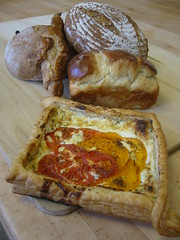July 11th, 2007
Bread Intensive, Day 3

Golden Raisin-walnut bread, whole wheat croissant, 5 grain levain, brioche loaf, puff with goat cheese and heirloom tomatoes.
Today was amazingly productive. I think I now have some insight into the world of a baker. And I enjoy it, so it must be a good sign. Lots of multi-tasking. Yesterday, we made our pre-ferments for the 5-grain Levain and Golden Raisin Walnut Bread (with a stiff biga starter-which is yeasted starter that is set out to rise overnight. it is what gives Italian bread it’s unique earthy flavor and uneven crumb). A levain is a type of sourdough starter, consisting of natural yeasts that feed on flour. Levain starters are a French style and tend to be doughier (more flour than water) than most home sourdough starters (which are 1:1 flour/water ratio). Our chef started his levain using rye flour, since rye tends to have more yeasts naturally occuring in the flour. You hydrate the flour and let it sit out at room temperature for days. Some people add a little commercial yeast to get the starter started. Once the natural yeasts (which are in the flour, in the air, all around us) get going, they multiply and dominate the starter and the commercial yeasts eventually die out. The beautiful thing about yeast is that it is unique to your location, sort of like wine grapes. A San Fran sourdough will taste different than a Seattle sourdough just because the strain of yeast is different.
Pre-ferments are sort of a focused sourdough. For today’s preparations we took part of the levain mother and fed it with the proportions of flour and water specified by the recipe. We left the pre-ferments out at room temperature overnight to get the yeast busy so the bread will rise adequately for the next day. The 5-grain also consisted of a “soaker” which was a mixture of cracked rye, oats, flax and sunflower seeds that also sat out overnight (to soften and ferment a little). Both breads were pretty straightforward in making with a bulk fermentation, shaping, proofing and baking. They both were delicious and hearty. The hard work was with this turn business.

Chef squaring off croissant dough.
We finished all six turns of our puff pastry and three turns of the whole wheat croissants. Creating the turns is quite an elaborate process. Not only do we have to roll out the dough, but we have to roll out the butter to be exactly half the size of the dough. A nice cheater method is to lay plastic wrap on a half sheet pan, whip up a 2# of butter and spread it evenly on the sheet pan. Then refrigerate until firm. Once the dough has been rolled out to roughly the size of a full sheet pan, you can pop the butter block onto the dough and sandwich the other side on it. This is not a turn (but it’s one layer of butter). Our chef made us do one turn by hand, which must have taken about 15 minutes. The goal is to roll out the dough so that it’s three times the length of the original size, then fold it into thirds. THAT is the first turn. (now there are 3 butter layers). Standard puff pastry has 6 turns. We were lucky to use a sheeter that could roll out the dough in about a minute for us and we would fold it by hand. Thank goodness for that. I would never want to make this at home with my wine bottle rolling pin. The croissants have 3 turns. We had a hard time with those because we used a coarse whole wheat flour and it cut the gluten strands a bit, so some butter broke through during the rolling process. Chef said it was fine and since the dough was chilled while putting the turns on it the butter stayed in place.
Once all the correct turns have been done (making a million or so butter layers) we rolled out the dough to #5 on the sheeter (about 1/8″ thick). We cut the croissants into 2.5 oz triangles and rolled them into the appropriate shaped and baked them. Rolling croissants was easier than I thought. We used a bench scraper to cut out triangles of the rolled dough (about 3″ wide and 4″ long). A slight tug was made to teh tip of the triangle, then we rolled, wide end toward the point. Make sure to make your first roll tight, then just roll it towards you, keeping it cylindrical. The puff was more exciting, like making paper snowflakes. I think they baked up beautifully and now I have some more techniques under my belt apron.


